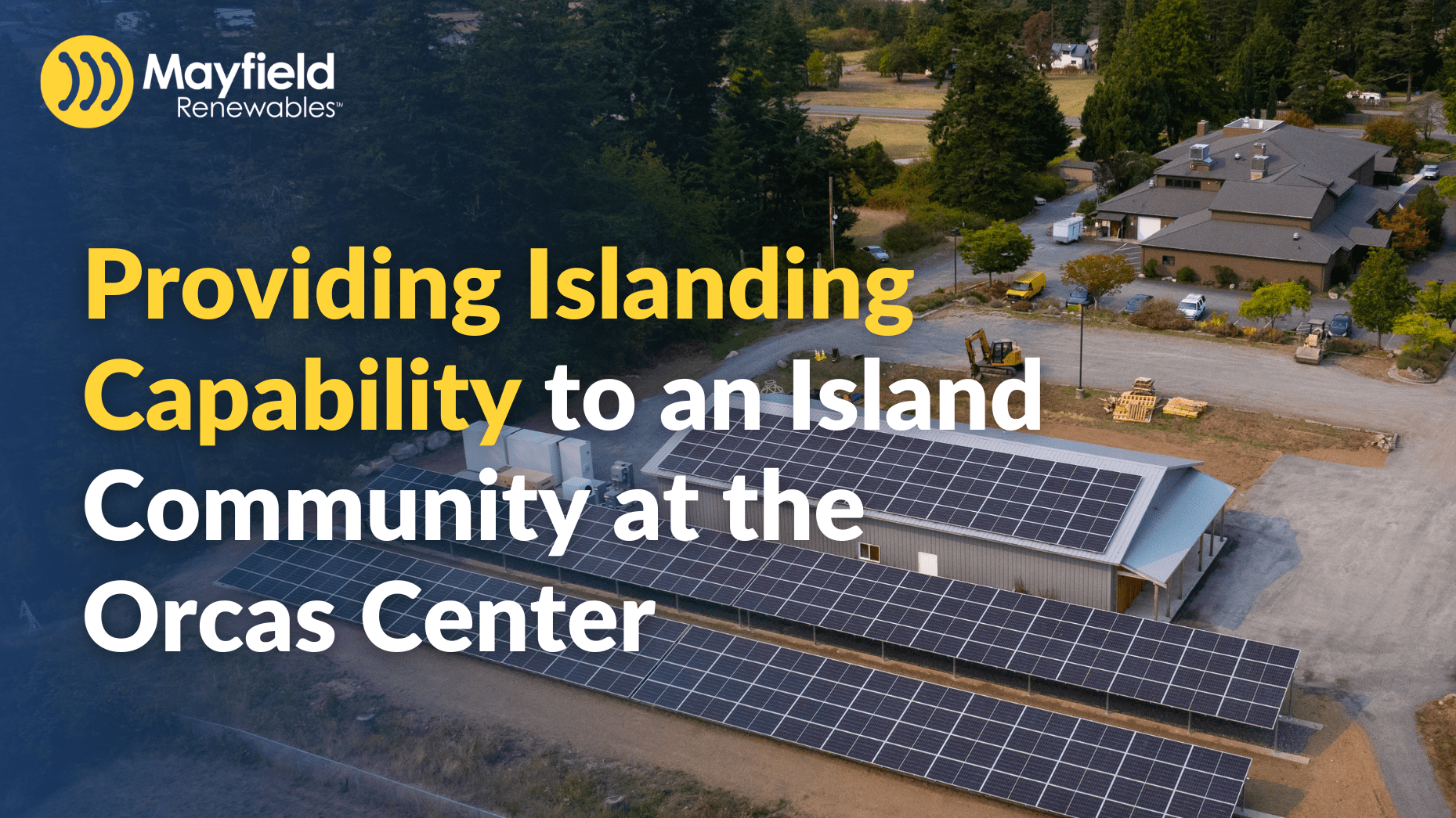
Technical Article
Providing Islanding Capability to an Island Community at the Orcas Center
“Most of the time, it feels like we’re on the mainland,” said former Executive Director Dimitri Stankevich. “But in a large-scale emergency, we become very isolated here.”
Powered by a single undersea transmission line and accessible only by ferry or small plane, Orcas Island is uniquely vulnerable to disruption. In the event of an earthquake, wildfire, or severe weather, residents could be cut off from critical supplies and services for days.

The San Juan County Emergency Management (SJCEM) agency identified the Orcas Center as a facility that could function as a critical emergency support hub if reliable backup power could be installed. At the time, however, the Center had no energy resilience infrastructure. A prolonged outage would leave it dark and inaccessible just when the island needed it most. Recognizing this gap, SJCEM began exploring options for a solar- and battery-based microgrid system that could keep essential services online during emergencies while reducing operating costs under normal conditions.
In other words, this island facility was interested in “islanding” from the grid.
Project Overview
Based in Bellingham, Washington and with a history of Pacific Northwest community-led microgrid development, Cascadia Renewables was selected as the EPC for the Orcas Center project. Cascadia worked with local partners from MZ Solar Consulting to perform preliminary analyses and Mayfield Renewables to lead planset development and to act as the electrical engineer of record.
By the time Mayfield became involved, Cascadia had already defined performance goals for the microgrid, and MZ had estimated the distributed energy resource (DER) sizes required to meet those goals. Mayfield validated the initial design for code compliance, worked with the Orcas Center and the local AHJ to determine equipment locations, and defined roles and responsibilities to fulfill the complex system controls functions.
The group arrived at the following system configuration, which offsets approximately 87% of the Orcas Center’s annual energy use:

In a grid outage, the microgrid system can:
- Operate independently for up to 56 hours in the winter without generator support
- Maintain continuous autonomy in the summer through solar charging
- Maintain continuous emergency operation through the winter with 33–56 additional hours of generator runtime (70% reduction over the generator-only scenario)
The ELM energy storage system also enabled value stacking, going beyond resilience to provide demand charge reduction and energy arbitrage when connected to the grid.
Engineering Lessons Learned
There’s something to learn from every microgrid project, and the Orcas Center was no exception. We took away a few key insights:
Quality load analysis = more confident assumptions. We had to downsize the main breaker from 2000AF/1600AT to a 1200A, three-pole motorized breaker to enable islanding functionality and connect on the load side of the main switchboard. Luckily, we had access to 15-minute interval data from the utility. Working with MZ Solar Consulting, we re-ran load analyses to confirm the downsized breaker would be sufficient to power existing loads.
This is not always the case! Often, we have limited load data to work with and have to adjust our calculations and assumptions accordingly. Best practice for microgrid resource sizing is to obtain as high quality, high resolution data as possible by gathering utility interval data or installing meters onsite to perform a load study.
Start your sequence of operations planning early. The Orcas Center microgrid relied on two separate relays and motorized breakers to coordinate solar PV, battery energy storage system (BESS), and generator dispatch: The primary relay in the main switchboard islands the microgrid when it senses a grid outage. The secondary relay on the generator pad senses when the PV and BESS can no longer meet facility loads, or when the BESS falls below a programmed state of charge, turning on the generator in either scenario.
Accomplishing this level of controls coordination is not a simple task. For this project, in particular, we had to align all stakeholders on the project goals to aid in relay selection. Best practice is to assign controls-related roles and responsibilities as early as possible in a project by collaborating with the system owner (to define system goals), the developer (to procure and install, and coordinate between equipment manufacturers), the electrical engineer of record (to verify code compliance and provide conceptual sequence of operations support), and the controls provider (for completing the sequence of operations development, programming, and commissioning the controls onsite).
Know your fire code. The Orcas Center had limited space to work with, and wanted to colocate all microgrid equipment at the south end of the property for ease of installation and maintenance. Local zoning ordinance required an extended 20 ft setback from adjacent property lines, and the desired equipment area was surrounded with trees and shrubs, which presented a fire hazard. We ended up clearing vegetation and following equipment spacing requirements to size and locate the pad – maximizing the amount of available space for equipment while satisfying the fire marshal.

Best practice here is, as always, to work closely with your AHJ and fire marshal to determine their BESS size and setback requirements. If you’re looking to brush up on fire code, consider registering for one of our self-paced online courses or check out our free Code Corner series on YouTube.
A Template for Community Resilience
Today, Orcas Center functions as a dual-purpose hub—supporting arts and culture under normal conditions and providing essential services during grid disruptions. Its small-footprint design offers a template for other community facilities across the country.
Mayfield and Cascadia Renewables’ feasibility-first, stakeholder-informed, technically grounded approach demonstrates how thoughtful engineering can deliver measurable resilience.
“This project demonstrates exactly what the [Washington State] Climate Commitment Act was designed to do — deliver reliable, low-carbon energy solutions that help communities thrive in a changing climate,” said Washington State Representative Alex Ramel.
Mayfield Renewables is an engineering consultancy specializing in commercial and industrial PV and microgrid engineering. Contact us today for a consultation.




